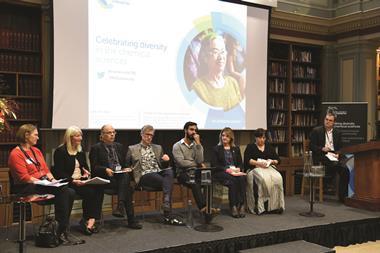Academic staff who were female, Black or disabled were less likely to be submitted for assessment in the 2021 Research Excellence Framework (REF), new analysis has found. The findings appear to reflect entrenched issues with inequality and underrepresentation in the higher education sector.
The REF’s equality and diversity advisory panel looked at which staff were picked out of all eligible staff and had significant responsibility for research, the number of outputs attributed to each person and the assessed quality of outputs.
Women accounted for 42% of the total eligible population and men 58%. However, the rate of submission for female staff was 69% compared with 81% for male staff. Submission rates varied by subject with the largest difference in medical and health sciences where 63% of eligible women were submitted compared with 84% of eligible male staff. In the physical sciences this difference fell to five percentage points and in social sciences to ten percentage points. Female staff also submitted slightly fewer outputs on average than men – two per person compared with 2.29 for men. But this difference could relate to maternity-leave related adjustments, the report notes.
White staff made up 78% of the eligible headcount compared with Black (2%) and Asian (9%) staff. Eligible Black staff were less likely to be identified as having significant responsibility for research than staff from other ethnic backgrounds. The submission rate for Black staff was 53% compared with 75% for white staff and 80% for Asian staff.
Lower submissions rates were also observed for disabled staff (64%) compared with non-disabled staff (76%). However, rates for gay, lesbian and bisexual academics were similar to heterosexual staff.
The report notes that several institutions pointed out that the underrepresentation was not necessarily due to the impact of REF processes, but rather that the exercise highlighted existing structural inequalities in the sector. ‘This ranges from the stark picture painted by data on increasing underrepresentation of some groups through the research career stages through to evidence about differences in key areas of research activity and performance, such as grant funding, citations and so on, that collectively highlight the structural inequalities permeating the research landscape.’
However, the authors highlight that the study does have limitations. For instance, very small numbers make it difficult to draw reliable conclusions for some groups.
‘The results don’t strike me as surprising, but they are disappointing,’ says Athene Donald at the University of Cambridge. ‘The particularly large differences observed between men and women’s likelihood of submission, ties in with analysis submitted by institutions, which showed that the vast majority of those who had looked into this, reported an underrepresentation of female staff in the submitted population. In other words, problems remain in the structures of [higher education institutions] and career progression. Such structural inequalities need to be eradicated, but progress is dismally slow. A similar pattern would seem to apply to Black researchers, although not to those of other ethnicities.’
There are ‘possible relatively benign explanations’, she adds, not revealed by analysing the REF data alone, such as patterns of working, which institutions are most likely to employ women and Black researchers, and what they ‘choose’ to do. ‘But “choice” in this sense is not always voluntary, and [higher education institutes] need to do much more to level the playing field if white men are not to remain the dominant demographic as we move forward, to the disadvantage of many others,’ she adds.












No comments yet